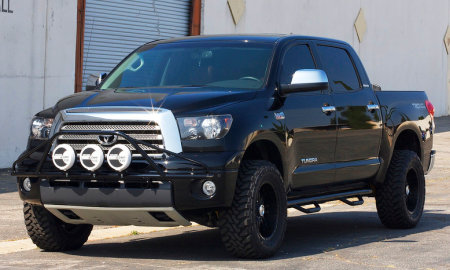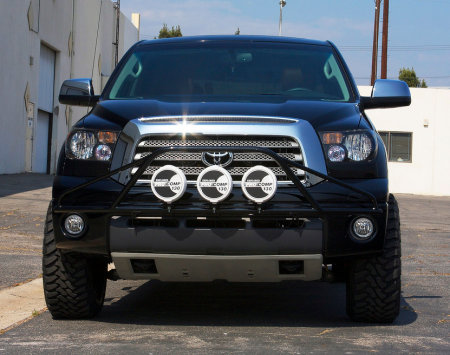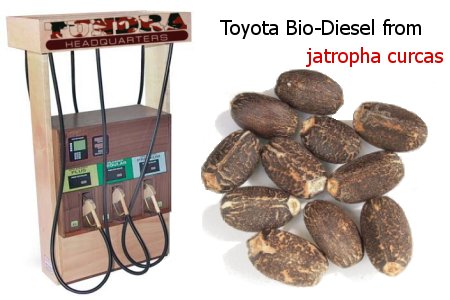
 Author Archive for Jason Lancaster
Author Archive for Jason Lancaster
Jason Lancaster is the editor and founder of TundraHeadquarters.com. He has nearly a decade of experience on the retail side of the auto industry, and another decade of experience of the part and accessory side of the industry.
Todd’s Rogue 2008 Tundra Crew
Here’s a look at Todd’s “Rogue Squadron” 2008 Toyota Tundra Crewmax Limited.

'Rogue Squadron's' Black 2008 Toyota Tundra Crew
As you can see, it’s a TRD 4×4 with a clean-as-can-be black paint job. We really like the black rims on this truck – it looks great but it’s also a very practical off-road choice – fancy rims are too expensive to risk scuffing up on the trail.

N-Fab brush guard and Pro-Comp fog lights.
Kudos to Todd for his clever exhaust setup on this truck – he added a set of Flowmaster Super 40 mufflers to the TRD exhaust system. A lot of people don’t think that the standard TRD exhaust is aggressive enough, and Todd’s modification is a simple way to get more sound out of the TRD kit while maintaining the TRD kit’s fit and finish.
Toyota Making Bio-Diesel Investment in Philippines
Toyota and the Philippine government have reached a basic memorandum of understanding in regards to creating a bio-diesel production facility (see Manila Standard). This is only the first step in a very long process, but it represents an interesting investment on behalf of Toyota. Considering that Toyota is cutting costs everywhere, investing in a bio-diesel plant in this economic climate could only be justified if it was a strategic move.

Toyota invests in bio-diesel made from jatropha curcas.
First, a little background. Toyota’s bio-diesel investment will be a small scale jatropha curcas plantation and refinery. Depending on how the trial goes, Toyota may invest in a facility capable of producing 7 to 8 million gallons of bio-diesel per year. Toyota’s bio-diesel crop of choice – jatropha curcas seeds (also known as purging seeds) – are desirable number of reasons.
Toyota Managing Tundra Inventory Supply VERY Closely
Late last week, Toyota announced that they were going to increase Tundra production. Many auto industry pundits announced that this move was nothing more than Toyota stepping back up to a “normal” level of production. At first blush, I agreed with that assessment.
Today, after reading a news story from the Dallas Morning News, I’m not so sure. It seems like Tundra demand is starting to climb…
Toyota Tundra Cash For Clunkers Notes
As you’ve undoubtedly heard, congress is very close to passing a so-called “cash for clunkers” bill (technically known as “Consumer Assistance to Recycle and Save Act“).
The idea behind this bill is to get older, less fuel-efficient vehicles off the road and replace them with newer cars and/or trucks. The hope is that this bill will 1) Help kick-start auto industry sales and 2) improve the environment by crushing a bunch of older vehicles that are currently polluting.
While there are a lot of very smart people who dislike this bill – either because it’s not environmentally sound or because it’s not going to work – the fact is that none of this seems to matter. The bill was passed by a healthy majority in the House of Representatives, and most analysts seem to think it will pass in the Senate and be signed into law shortly. So, with that in mind, here’s what you need to know if you’re considering buying a new Toyota Tundra using a Cash For Clunkers voucher:
Tinting Your Truck Windows – Toyota Tundra Tint Tips
Few accessories set off a pickup truck quite like tinted windows – especially if you live in a hot climate. Tinting the windows of your Toyota Tundra can be one of the most cost effective truck modifications you will ever make, and not just from an aesthetic perspective. Tinted windows can keep the Sun out of your truck’s passenger compartment and combat the “greenhouse effect” that can raise inside temperatures, and they’re also great for boosting vehicle privacy.
How exactly are windows tinted? There are two basic approaches to the process. The cheapest is to use do-it-yourself window tinting film, which is designed to either use static cling to affix itself to your windows or is meant to be applied with a soapy solution in order to form a bond against the glass. With a lot of hard work chasing out air bubbles and cutting the film so that it is the proper size, passable results can usually be obtained for at least the first few weeks. However, this type of tint tends to mark up easily, a fact which is only made worse by the rolling up and down of windows. After a few months, the typical do-it-yourself tint will look tattered, torn, and faded (usually turning a slight purple color).
w
![]() photo credit: Grumpy Chris
photo credit: Grumpy Chris
Check out this Mini’s dark and mirrored hybrid tint film – very sharp.
A far better option is to visit a local and reputable window tint shop.
Search terms people used to find this page:
- tundraheadquarters



